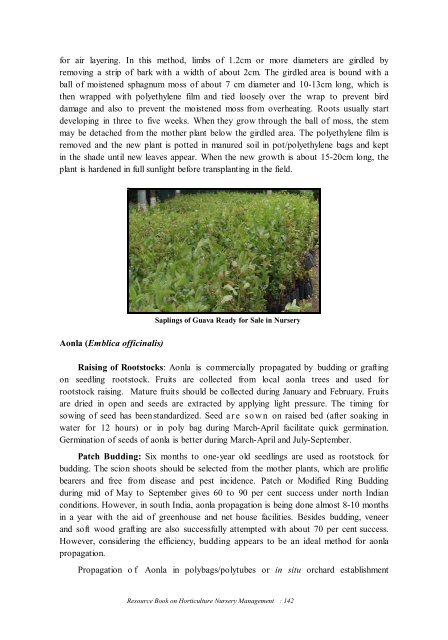Resource Book on Horticulture Nursery Management
Resource Book on Horticulture Nursery Management
Resource Book on Horticulture Nursery Management
Create successful ePaper yourself
Turn your PDF publications into a flip-book with our unique Google optimized e-Paper software.
for air layering. In this method, limbs of 1.2cm or more diameters are girdled by<br />
removing a strip of bark with a width of about 2cm. The girdled area is bound with a<br />
ball of moistened sphagnum moss of about 7 cm diameter and 10-13cm l<strong>on</strong>g, which is<br />
then wrapped with polyethylene film and tied loosely over the wrap to prevent bird<br />
damage and also to prevent the moistened moss from overheating. Roots usually start<br />
developing in three to five weeks. When they grow through the ball of moss, the stem<br />
may be detached from the mother plant below the girdled area. The polyethylene film is<br />
removed and the new plant is potted in manured soil in pot/polyethylene bags and kept<br />
in the shade until new leaves appear. When the new growth is about 15-20cm l<strong>on</strong>g, the<br />
plant is hardened in full sunlight before transplanting in the field.<br />
A<strong>on</strong>la (Emblica officinalis)<br />
Saplings of Guava Ready for Sale in <strong>Nursery</strong><br />
Raising of Rootstocks: A<strong>on</strong>la is commercially propagated by budding or grafting<br />
<strong>on</strong> seedling rootstock. Fruits are collected from local a<strong>on</strong>la trees and used for<br />
rootstock raising. Mature fruits should be collected during January and February. Fruits<br />
are dried in open and seeds are extracted by applying light pressure. The timing for<br />
sowing of seed has been standardized. Seed ar e so w n <strong>on</strong> raised bed (after soaking in<br />
water for 12 hours) or in poly bag during March-April facilitate quick germinati<strong>on</strong>.<br />
Germinati<strong>on</strong> of seeds of a<strong>on</strong>la is better during March-April and July-September.<br />
Patch Budding: Six m<strong>on</strong>ths to <strong>on</strong>e-year old seedlings are used as rootstock for<br />
budding. The sci<strong>on</strong> shoots should be selected from the mother plants, which are prolific<br />
bearers and free from disease and pest incidence. Patch or Modified Ring Budding<br />
during mid of May to September gives 60 to 90 per cent success under north Indian<br />
c<strong>on</strong>diti<strong>on</strong>s. However, in south India, a<strong>on</strong>la propagati<strong>on</strong> is being d<strong>on</strong>e almost 8-10 m<strong>on</strong>ths<br />
in a year with the aid of greenhouse and net house facilities. Besides budding, veneer<br />
and soft wood grafting are also successfully attempted with about 70 per cent success.<br />
However, c<strong>on</strong>sidering the efficiency, budding appears to be an ideal method for a<strong>on</strong>la<br />
propagati<strong>on</strong>.<br />
Propagati<strong>on</strong> of A<strong>on</strong>la in polybags/polytubes or in situ orchard establishment<br />
<str<strong>on</strong>g>Resource</str<strong>on</strong>g> <str<strong>on</strong>g>Book</str<strong>on</strong>g> <strong>on</strong> <strong>Horticulture</strong> <strong>Nursery</strong> <strong>Management</strong> : 142











